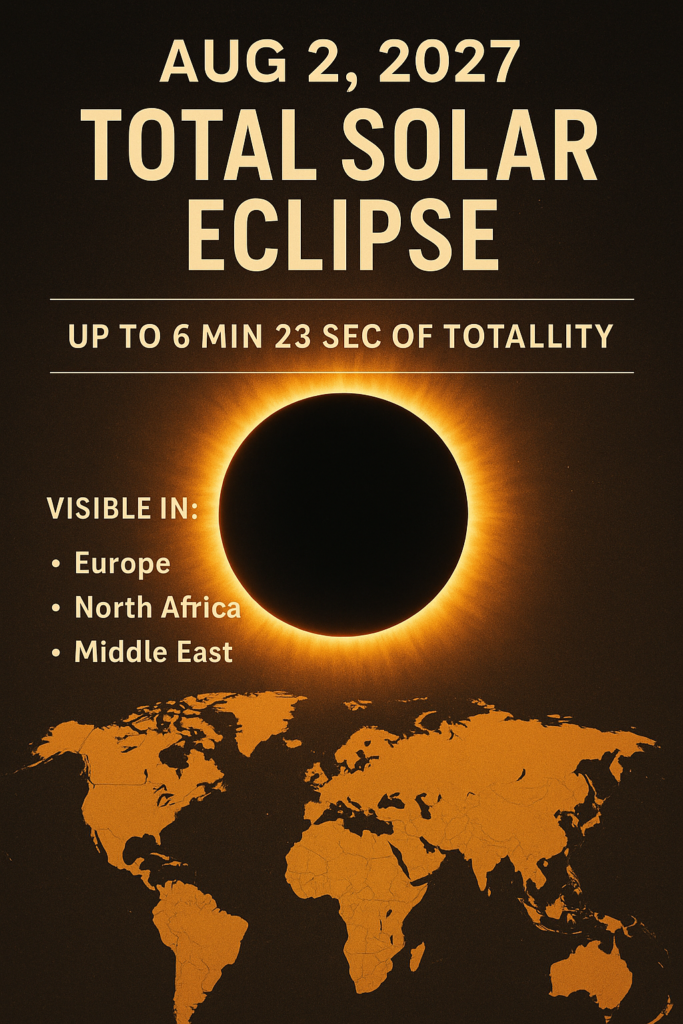Physical Address
304 North Cardinal St.
Dorchester Center, MA 02124
Physical Address
304 North Cardinal St.
Dorchester Center, MA 02124


Mark your calendars for August 2, 2027—a date that promises to deliver one of the most spectacular celestial events of the century: a Total Solar Eclipse. With a projected duration of up to 6 minutes and 23 seconds, this event will be the longest total solar eclipse visible from Earth in nearly 100 years.
Whether you’re an amateur skywatcher or a seasoned eclipse chaser, this event is not to be missed.
A total solar eclipse occurs when the Moon completely covers the Sun, casting a shadow on Earth and briefly turning day into night. During this rare alignment, the Sun’s corona becomes visible—offering a stunning, otherworldly visual experience.
Sunday, August 2, 2027
The total eclipse will be visible across:
| City | Start of Eclipse | Totality Duration | Max Eclipse Time |
|---|---|---|---|
| Luxor, Egypt | ~09:00 AM local time | ~6m 23s | ~10:04 AM |
| Mecca, Saudi Arabia | ~09:10 AM local time | ~6m 20s | ~10:15 AM |
| Murcia, Spain | ~09:30 AM local time | ~1m 20s | ~10:35 AM |
Note: Times vary by city. Check timeanddate.com for exact local timings.
Never look at the Sun without proper eye protection, even during a partial eclipse. Use the following methods:
If you’re planning to travel for the eclipse, consider these top destinations within the path of totality:
The 2027 eclipse offers a valuable opportunity for:
NASA, ESA, and several universities are expected to launch observation projects and livestreams.
| Date | Type | Visible From |
|---|---|---|
| Sep 21, 2025 | Partial Solar Eclipse | Australia, Antarctica, Pacific |
| Aug 12, 2026 | Total Solar Eclipse | Greenland, Iceland, Spain |
| Aug 2, 2027 | Total Solar Eclipse | Spain, North Africa, Middle East |
| Sep 2, 2035 | Total Solar Eclipse | China, Mongolia, Japan |
Q1: Will the eclipse be visible in the United States?
👉 Only a brief partial eclipse at sunrise in parts of Maine.
Q2: How long will totality last?
👉 Up to 6 minutes and 23 seconds, depending on location.
Q3: Is this the longest eclipse of the century?
👉 Yes, it is expected to be the longest total solar eclipse of the 21st century.
Q4: What causes a total solar eclipse?
👉 It happens when the Moon aligns perfectly between the Earth and Sun, completely blocking sunlight.
Q5: Can I look at the eclipse with sunglasses?
👉 No. You must use ISO-certified eclipse glasses or other safe viewing methods.
Q6: What’s the best place to view the eclipse?
👉 Egypt, Tunisia, and Saudi Arabia offer some of the longest views of totality with clear weather.
The August 2, 2027 Total Solar Eclipse will be one of the most awe-inspiring events of our lifetimes. With a duration of over 6 minutes and visibility across historic landscapes, it’s a unique blend of science, wonder, and cultural significance.
Start preparing now—whether through travel, education, or safe viewing equipment. This is a once-in-a-century event that skywatchers and scientists alike won’t want to miss.